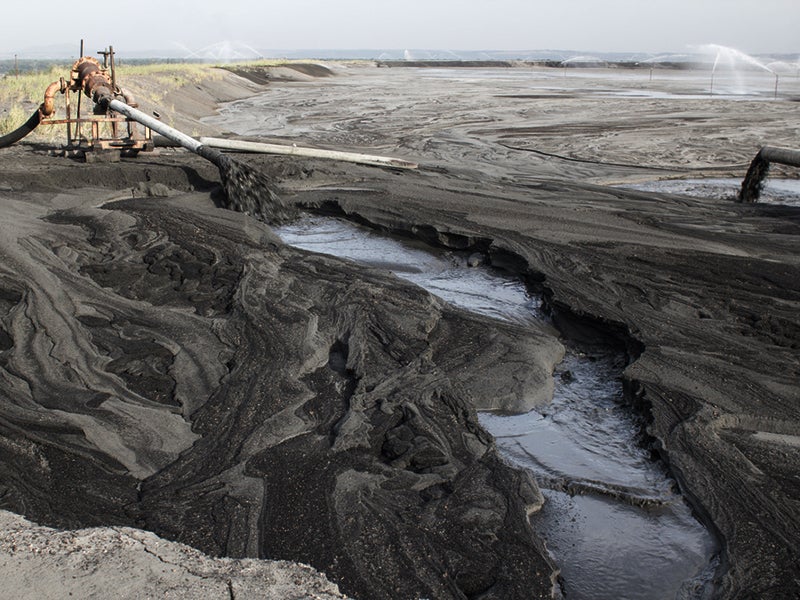Coal Ash: A Civil Rights Issue
The EPA has a well-documented problem with allowing coal ash waste to pile up in low-income communities of color.

This page was published 9 years ago. Find the latest on Earthjustice’s work.
“You have to understand the rural way of life: People sat on their porch and enjoyed the air, and they talked to each other. Now they live across the street or down the road from the landfill and it smells … People no longer let their grandchildren play in the yard without fear. The smell, the pollution and the fear affect all aspects of life—whether we can eat from our gardens, hang our clothes or spend time outside. This isn’t right.”
This is the voice of Esther Calhoun, a resident of Uniontown, Alabama, whose life has been greatly diminished because of coal ash. Ms. Calhoun is in Washington, D.C., this week to testify before the U.S. Commission on Civil Rights about the fact that the U.S. EPA is failing to protect minority and low-income Americans from coal ash pollution.
Coal ash is the toxic waste left over from burning coal in power plants to produce electricity, and it is the second largest source of industrial waste in the nation. In 2014, the EPA finalized a coal ash rule that established the first-ever federal safeguards on coal ash dumping. But the EPA failed to fix major pollution problems in communities like Esther’s because the rule puts the burden of enforcement on citizens, rather than requiring government regulators to take action. To make matters worse, the EPA rule allows the continued operation of dangerous coal ash lagoons—the majority of which are located in low-income and minority neighborhoods. Toxic waste can leak slowly from these unlined lagoons, poisoning underlying drinking water aquifers, and catastrophic failures can occur, endangering lives and property. Consequently, the EPA’s coal ash rule results in an unequal and unjustified threat of harm to poor and minority Americans.
Attention to the unequal harm wrought by coal ash pollution is long overdue. The federal coal ash rule was delayed for decades by the electric utility industry, which demanded an exemption from any reasonable rules governing the disposal of their toxic waste. The industry successfully blocked the rule for more than 30 years, while toxic sludge, dumped into unlined lagoons and landfills, piled up across America, particularly in neighborhoods where residents could least afford it. In the wake of two major disasters—the catastrophic collapse of the TVA dam in 2008 and the Duke Dan River spill in 2014—the EPA was forced to act. But in the end, the EPA’s weak coal ash rule, while affording some needed relief, fails to alleviate the disproportionate harm suffered by America’s most vulnerable communities.
We welcome the U.S. Commission on Civil Rights’ focus on this critical public health issue. However, acknowledging the inequitable risk of harm from coal ash dumping is only the first step. It is our hope that shining a spotlight on this issue—through the testimonies of affected citizens, public health professionals, civil rights experts and environmental advocates—will lead to immediate action by the EPA to ensure that the coal ash rule protects every American community.
Adequate and equitable protection under the coal ash rule will not happen without the EPA’s immediate assistance. Coal ash pollution must not be allowed to create another crisis like the one unfolding in Flint, Michigan, where serious, irreversible and avoidable harm occurs because regulatory agencies fail to act. The U.S. Commission on Civil Rights’ briefing demonstrates that vulnerable communities face significant threats that are not being addressed by the new rule. The EPA has the authority and the technical expertise to address these disparities. For example, the EPA can take some simple but critical steps immediately, such as testing the drinking water near coal ash lagoons in minority and low-income communities, providing technical assistance to these communities to help them enforce the new coal ash rule and facilitating access to potentially life-saving information about coal ash dumps in these neighborhoods.
The EPA is required under executive order to assess the unequal impacts of coal ash pollution and then to address those impacts. However, to date, the EPA has only documented the disparate impacts. For people like Esther Calhoun in Uniontown who must live with the harmful impacts of coal ash day in and day out, the time to act is now.
For more information on the coal ash problem, see the Earthjustice special feature Coal Ash Contaminates Lives.
Earthjustice’s Clean Energy Program uses the power of the law and the strength of partnership to accelerate the transition to 100% clean energy.